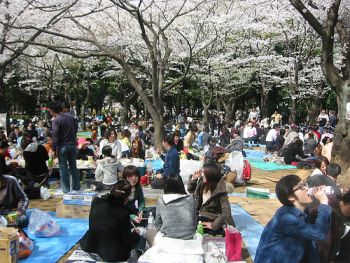Hanami
Hanami (in Japanese flower viewing) is a very popular Japanese tradition where people gather to observe the beauty of flowers. Hanami mainly includes viewing of cherry (“sakura”) and Japanese plum (“ume”) blossoms. According to experts tradition of flower viewing first appeared during the Nara Period (710–794). First it was part of the Japanese elite. In the Edo Period (1603-1868) popular among the common people too.
Depending on the part of Japan sakura blossom appear from mid January until late May. They only last between one and two weeks. That is why the Japan Meteorological Agency each year announces its “blossom forecast” or “sakurazensen.”
 Hanami
Hanami
Nowadays people observe cherry blossoms by having a picnic under a cherry tree in one of parks. Observing is done during both day and night. The observing in the night is called “yozakura” or “night sakura.” Parks where people observe cherry blossoms in the night have hanging paper lanterns.
People start arriving in the park very early in the morning to get the best spot. It is not unusual that some companies send an employee to keep a place reserved for the company employees who will arrive after work.
Parks in Tokyo known to be the best for Hanami are Shinjuku Gyoen, Ueno, Chidorigafuchi and Sumida. Some of other places famous among true Hanami fans are Philosopher's Path in Kyoto, Kema Sakuranomiya Park in Osaka and Yoshinoyama (Mount Yoshino) in the Nara Prefecture.